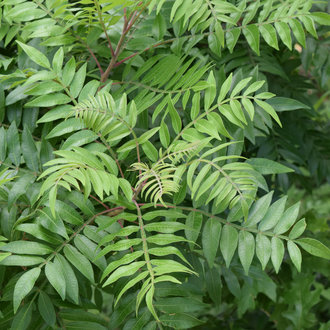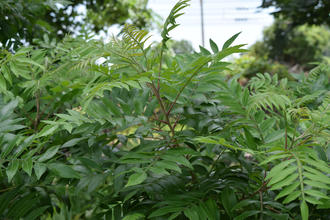Winged Sumac (Rhus copallinum L.)
Also known as dwarf sumac, shining sumac; also classified as Rhus copallina.
↑Summary
A thicket-forming shrub native to eastern North America; a short-lived pioneer species, most common in well-drained portions of bottomlands.
↑Range - Expand
| Legend | Color |
| Native | |
| Native or Not Present |
This tentative map is based on our own research. It may have limited data on Canada and/or Mexico, and there is some subjectivity in our assignment of plants as introduced vs. expanded. Read more in this blog post.
Although this plant occurs somewhere in each of these regions, it may only occur in a small part of some or all of them.
↑Description & Identification
A shrub to small tree, often with one plant having many trunks connected to a single root system. Reaches 20 to 30 feet (6-10 m) but often much shorter. Fruit is a cluster of red berries, more loosely-packed and often less upright than other sumac species with large fruit clusters.
Compound leaves have distinctive "wings" along the central leaf stalk, a feature lacking from other similar-looking species.
↑Habitat
Found in a variety of early-successional habitats, including recently-abandoned fields, recently-burned areas, as well as open woodlands, fencerows, and other border habitats. Growth is best on well-drained sites in bottomlands, in neutral to slightly acidic soil.
Sometimes found on poorly-drained soils, where it grows slower.
More abundant in habitats subjected to frequent fire.
↑Life Cycle
Winged sumac is a fast-growing, short-lived shrub to small tree, often forming clonal thickets. Compared to the other sumacs in its range with an upright growth habit, winged sumac is the shortest-lived.
Seed germination is often triggered by heat, such as from fire, but also able to establish in other open and disturbed habitats. Colonization of exposed sites occurs both from the seed bank and from fresh seed distributed by animals.
Growth is rapid, but in the absence of further disturbance, its dominance often declines 3-4 years after establishment.
Top-killed plants resprout vigorously from the root system.
↑Uses
Occasionally used in landscaping, where it is valued for its attractive form, fruit, and fall color, rapid growth, tolerance of poor sites, drought-tolerance, and small maximum size. Its use is somewhat limited by its tendency to spread vegetatively and sprout from the root system.
Can be used effectively for erosion control on areas with poor soils.
↑Links & External Resources
• Rhus copallinum (Winged Sumac) | USDA PLANTS Database (About This Site)
• Rhus copallinum | Go Botany (About This Site)
• Shining Sumac | iNaturalist (About This Site)
• Rhus copallinum (Winged Sumac) | Missouri Botanical Garden Plant Finder (About This Site)
• Shining Sumac | Virginia Tech Dendrology Factsheets (About This Site)
• Rhus copallinum | Biota of North America Project (BONAP) (About This Site)
• Rhus copallinum | NatureServe Explorer (About This Site)
• Rhus copallinum (Winged Sumac) | Fire Effects Information System (FEIS) (About This Site)
• Rhus copallinum | Missouri Plants (About This Site)
• Winged Sumac | Maryland Biodiversity Project (About This Site)
• Rhus copallinum L. var. latifolia Engler (Winged Sumac, Shining Sumac) | Digital Atlas of the Virginia Flora (About This Site)
• Rhus copallinum L. var. copallinum (Winged Sumac, Shining Sumac) | Digital Atlas of the Virginia Flora (About This Site)






